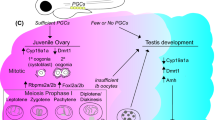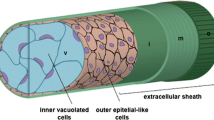Abstract
Morphogenetic movements accompanying formation of the neural keel and neural tube in the zebrafishDanino (Brachydanio) rerio were studied by labelling single neural plate cells with fluoresceinated dextran (FDA) during late gastrula stages (95–100% epiboly) and localizing their progeny with an anti-fluorescein antibody on histological sections throughout neurulation. The mediolateral extent of the neural plate correlates directly with the dorso-ventral extent of the neural tube. That is to say, the progeny of cells located medially in the neural plate come to lie ventrally in the neural tube; cells located laterally in the neural plate give rise to progeny that populate dorsal levels in the neural tube. Fixation of labelled cells at various stages reveals that neural keel and nerve rod are organized as monostratified epithelia and that they maintain this organization during neurulation. These observations strongly suggest that the neural keel in the zebrafish forms by way of infolding of the neural plate and, therefore, utilizes a mechanism similar to primary neurulation in other vertebrates. The folding process juxtaposes the apical surfaces of both flanks of the neural plate at the midline. Mitoses occur preferentially in this zone, leading very frequently to formation of bilaterally symmetrical clones of progeny cells. The size of the clones that develop from injected cells suggests that neural plate cells divide an 1.5 times on average between late gastrula and the end of neurulation.
Similar content being viewed by others
References
Balinsky BI (1981) An introduction to embryology, 5th edn. Holt-Saunders, Philadelphia
Criley BB (1969) Analysis of the embryonic sources and mechanism of development of posterior levels of chick neural tubes. J Morphol 128:465–502
Gimlich RL, Braun J (1985) Improved fluorescent compounds for tracing cell lineage. Dev Biol 109:509–514
Hartenstein V (1989) Early neurogenesis in Xenopus: the spatio-temporal pattern of proliferation and cell lineages in the embryonic spinal cord. Neuron 3:399–411
Holmdahl D (1932) Die zweifache Bildungsweise des zentralen Nervensystems bei den Wirbeltieren. Eine formgeschichtliche und materialgeschichtliche Analyse. Wilhelm Roux' Arch Entwicklungsmech Org 129:206–254
Hughes AF, Freeman RB (1974) Comparative remarks on the development of the tail cord among higher vertebrates. J Embryol. Exp Morphol 32:355–363
Karfunkel P (1974) The mechanism of neural tube formation. Int Rev Cytol 38:245–271
Kimmel CB, Law RD (1985) Cell lineage of zebrafish blastomeres. III. Clonal analysis of the blastula and gastrula stages. Dev Biol 108:94–101
Kimmel CB, Warga RM (1986) Cell lineages generating axial muscle in the zebrafish embryo. Science 231:234–237
Kimmel CB, Sepich DS, Trevarrow B (1988) Development of segmentation in zebrafish. Development 104 [Suppl]: 197–207
Kimmel CB, Warga RM, Kane DA (1994) Cell cycles and Clonal strings during formation of the zebrafish central nervous system. Development (in press)
Lemire RJ (1969) Variations in development of the caudal neural tube in human embryos (Horizons XIV–XXI). Teratology 2:361–370
Myers PZ (1985) Spinal motoneurons of the larval zebrafish. J Comp Neurol 236:555–561
Miyayama Y, Fujimoto T (1977) Fine morphological studies of neural tube formation in the teleostOryzias latipes. Okajimas Fol Anat Jpn 54:97–120
Nakao T, Ishizawa A (1984) Light- and electron-microscopic observations of the tail bud of the larval lamprey (Lampreta japonica), with special reference to neural tube formation. Am J Anat 170:55–71
Nelsen E (1953) Comperative embryology of vertebrates. McGrawHill, New York
Reichenbach A, Schaaf P, Schneider H (1990) Primary neurulation in teleosts. Evidence for epithelial genesis of central nervous tissue as in other vertebrates. J Hirnforsch 31:152–158
Schmitz B, Papan C, Campos-Ortega JA (1993) Neurulation in the anterior trunk region of the zebrafish,Brachydanio rerio. Roux Arch Dev Biol 202:250–259
Schoenwolf GC, Alvarez IS (1989) Roles of neuroepithelial cell rearrangement and division in shaping of the avian neural plate. Development 106:427–439
Schoenwolf GC, DeLongo J (1980) Ultrastructure of secondary neurulation in the chick embryo. Am J Anat 158:43–63
Schoenwolf GC, Sheard P (1989) Shaping and bending of the avian neural plate as analysed with a fluorescent-histochemical marker. Development 108:17–25
Schoenwolf GC, Smith JL (1990) Mechanism of neurulation: traditional viewpoint and recent advances. Development 109:243–270
Warga RM, Kimmel CB (1990) Cell movements during epiboly and gastrulation in zebrafish. Development 108:569–580
Westerfield MF (1989) The zebrafish book. Oregon Press, Eugene
Author information
Authors and Affiliations
Additional information
Correspondence to: J.A. Campos-Ortega
Rights and permissions
About this article
Cite this article
Papan, C., Campos-Ortega, J.A. On the formation of the neural keel and neural tube in the zebrafishDanio (Brachydanio) rerio . Roux's Arch Dev Biol 203, 178–186 (1994). https://doi.org/10.1007/BF00636333
Received:
Accepted:
Issue Date:
DOI: https://doi.org/10.1007/BF00636333




